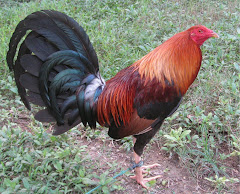Friday, January 9, 2009
Cockfighting opponents misleads legislature
by: Ben Moffett
For The Mountain Mail
Contact: benmoffett@comcast.net
A well-financed effort to ban the historic sport of cockfighting, a thriving sport in Socorro County and around New Mexico, has surfaced in recent years, leading to a constant stream of legislation that has failed repeatedly because a cadre of sympathetic legislators manage to pigeonhole it.
It appears that the current legislature will pass the ban, not because anyone has changed their mind, but for political expediency related to national and state politics, fund-raising, and unfavorable media coverage.
This may be the last change to write a column from the point of view of the cockfighters, who have never had their case in print.
In defense of cockfighters, it stands to reason that if one wants to fight avian (bird) cruelty, it would be most logical to legislate against falconers, who damage the wings of quail, pigeons and other birds, and toss them into the air to be killed by half-starved raptors who have been sitting blind-folded, tethered to a perch, until their owners decide it is mealtime.
However, falconers are viewed as genteel sporting men and women, a part of literature and storytelling, veritable Robin Hoods. Why? Social status? Wealth? Because falconry is a time-honored tradition dating back more than 2,000 years?
Animal rights organizations, including People for the Ethical Treatment of Animals, or PETA, have led the cockfighting “antis.” In 2005, PETA enlisted “Golden Girl” actor Rue McClanahan and comic and political commentator Bill Maher, among others, in its efforts to win the support of legislators and the general public in New Mexico. PETA’s extensive literature uses statements that drip with emotion, but misrepresent pertinent facts.
They also avoid applicable historical values, science, competing philosophical views, and, most critically, a comparative view of the treatment of animals across a broad spectrum of human interactions with livestock, pets, zoo animals, wildlife, and especially those avian species that have even less civil rights that roosters, such as falcons, quail and pigeons.
While animal rights organizations have done much good in promoting animal welfare in this country, we submit that they are on the wrong path on cockfighting, likely to cause more harm than good, while letting far greater acts of cruelty go unpunished.
Animal rights groups base their opposition on the following points – that cockfighters (1) are cruel to the roosters, especially since gaffs are attached to the birds’ feet; (2) foster an atmosphere harmful to children; (3) promote illegal gambling; (4) create an atmosphere that attracts a criminal element; (5) contribute to domestic violence by competing; (6) force roosters into unnatural acts (fighting with “knives”); (7) hurt tourism because cockfighting gives the state a bad name; and (8) wrongfully claim that cockfighting is a Mexican tradition that should be protected under the Treaty of Guadalupe Hidalgo.
Evidence to back these claims has been presented only through anecdotes and generalizations, dripping with emotion as most debates are.
Here are some cockfighting rebuttals I’ve heard that makes sense. On the charge of cruelty to animals, let me quote from former Associated Press and Albuquerque Journal reporter Larry Calloway’s blog, larrycalloway.com, March 14, 2003:
Said Calloway: “The proponents of the bill paint bloody pictures of the cockfight pits, where roosters slash each other with razor-sharp spurs in an area with no escape until one dies. But it seems the issue is not simply about chickens. After all, if you really want to alleviate the poultry suffering in a big way, go after Tyson Foods of Arkansas. …
“The processing of chickens is something you don’t want to see. Like fighting roosters, they have an apparent territorial instinct, and when this is violated, as it is when thousands are crammed together in cages while they grow, they tend to peck each other to death. That is why the factory processing begins with the assembly-line removal of little beaks by burning when the yellow chicks are just hatched.”
What Calloway could have added is that the chickens are the victims of an assembly line slaughter at the age of six weeks. Fighting cocks live to be three to five years old. The cocks are pampered and have plush, individual living quarters, the best feed, and, perhaps, some romance. When they are put into the pit, they go in without fear. In fact, they are set down appropriately angry and supremely confident, their endorphins chugging. Likely, when a fatal blow is struck, they merely lapse into pain-free shock, as often happens with humans. Any slow-pitch softball player can tell you that a head-first knee-scraping slide into home goes unnoticed in the heat of a game. That same natural endorphin “runners high” is present in fighting cocks. Also, the roosters aren’t worried about their mortality, having no awareness of it.
On number (2), fostering an atmosphere harmful to children, it’s true that a third grader who has never been out of the city might be shocked by such a spectacle, but the youngsters who go to the fights are schooled in the sport by helping care for the animals. They are typically farm and suburban youngsters who raise chickens themselves, and probably ring the necks of the chickens that go on the dinner table as part of their farm chores.
Number (3), that the fights promote illegal gambling, is undeniable. I’ve been to a few cockfights and spectators make bets through hand signals. None of the exchanged money, however, goes to the cockfight promoter. He or she breaks even by charging entry fees in order to provide an arena, hires staff, including referees and buy expensive software programs to insure accuracy in pitting roosters of equal weight against one another. Illegal gambling is rampant everywhere with Internet gambling, office sports pools and money changing hands in the same hand-signal fashion at any college football game.
Number (4), is creating an atmosphere that fosters a criminal element. The only argument I’ve ever seen by the “antis” literature indicated that 145 people were arrested in a raid on an illegal New York City cockfight and seven had outstanding warrants! Well isn’t that about right for any New York (or New Mexico) gathering – about one in 20 people have outstanding warrants?
While we’re on this anecdote, yes, there are illegal cock fights in New York City, and virtually every state in the union. Rules to ban cockfighting are seldom enforced, because America can’t stand too many more productive workers being locked up, losing their jobs, and having their children taken away, as one recent cockfighting bill proposed.
Number (5), the charge that cockfighting causes domestic violence, doesn’t seem likely to me, but it’s as hard to refute as it is to make the original statement with a straight face. Families usually go to cockfights as a group, and they all participate. If the killing in the pit causes human violence, perhaps matanzas should be banned, too. The pig’s severed head hidden from view and the butchering done behind closed doors.
Number (6), the idea that animals are being forced into human-perpetrated unnatural acts, has little merit, in my view. Roosters fight, whether they are gamecocks or Rhode Island Reds. Giving them extra artillery in the form of cockspurs or sharpened natural spurs only bring the fights to a quicker end.
Number (7), hurting tourist. Yes, it may cause a boycott, but it certainly fills up motel rooms around Socorro at certain times of the year. And Louisiana, which has arenas featuring closed circuit television for cockfights, doesn’t seem to suffer.
Number (8), the cockfighters believe that, under the Treaty of Guadalupe Hidalgo, Mexicans are entitled to maintain their cultural traditions. Spending money to win such a court case, could be a good way for the “antis” to win in court, but it’s not one that will bring us closer together as a nation. Also, according to Wikipedia, the free online encylopedia, “Nicaragua, Belgium, Colombia, France, Mexico, Dominican Republic, Italy, Philippines, Perú, Puerto Rico, Canary Islands and Guam, have well-established arenas with seats or bleachers for (cock-fighting) spectators surrounding the ring. … In many countries, the spectacle draws whole families and in some countries, cockfighting is as popular as baseball and football in the United States.”
What I found on the Internet is that in the United States, we consumed 86 pounds of chicken per capita in 2005. If each chicken weighted two pounds – that’s a big chicken – we each eat 43 chickens. Multiply that times 300 million Americans and you can figure that we slaughter 2.9 billion chickens a year.
Of course, we need the protein. Somehow, I at least feel more sorry for the mongrel dog pacing up and down the fence line all day waiting for his owners to come back to the suburbs, than I do for a rooster in a knife fight. I think animal rights activists are putting their money in the wrong places.
Welcome. To read the articles, please click post link or month, then subsequent post link.
Ponkan broodcock

One of the ponkan broodcocks being readied by RB Sugbo for the incoming breeding season. RB Sugbo is among the gamefowl farms very much involved in the Masang Nagmamanok (MANA) Inc. nationwide gamefowl dispersal program.
Another ponkan

Another ponkan broodcock in the trio pen.
Mana: Dami at Pagkakaisa
Walang duda napakalaki na ng pinagunlad ng sabong mula sa paging libangan tuwing araw ng Linggo, ito ngayon ay isa nang napakatanyag na isport, malaking industriya at kaakitakit na mapagkakitaan.
Napakarami nang nagpapalahi ng manok panabong. Nagsilabasan ang mga babasahin at programa sa telebisyon ukol sa sabong.
Sa bawat nagpapalahi, ilan ang tagapagalaga ng kanyang manok? Sa bawat may-ari ng sabungan, ilan ang naghahanapbuhay sa sabungan niya? Sa bawat kasali sa derby, ilan ang nagbabayad sa pinto upang manood? Sa bawat malaking sabungero, ilan ang mayroon lang iilang pirasong tinale sa kanilang bakuran? Dapat lang, at napapanahon na siguro, na ang masang sabungero ay mapagtuonan ng pansin, mabigyan ng kinatawan, at, marinig ang boses sa isport at industriya ng sabong.
Ito ang nais abutin ng MANA (Masang Nagmamanok), isang pambansang kilusan at samahan ng mga masang sabungero. Ang mga layunin ng MANA ay ang sumusunod:
1. Ang pangalagaan ang kapakanan ng mga maliit na sabungero, partikular na, ang mga naghahanapbuhay sa sabungan. Inaasam na sa darating na panahon, ang mga handlers, mananari, casador, kristos, sentensiyador, farm hands ay magkakaroon ng mga benepisyo tulad ng insurance, pension at iba pa.
2. Ang mapatingkad ang kaalaman ng ordinaryong sabungero sa pagmamanok. At, sila’y mabigyan ng pagkakataon na magkaroon ng angkop na materyales sa pagpapalahi at paglalaban.
3. Ang ipaglaban ang sabong sa gitna ng banta na itoy gawing labag sa batas tulad ng nangyari kamakailan lang sa Estados Unidos, at ipreserba ito bilang isport, hanapbuhay, industriya at bahagi ng ating kultura at tunay na mana.
4. Ang magtulungan at makipagtulungan sa iba pang haligi ng industriya sa ikabubuti ng sabong at ikauunlad ng lahat na mga sabungero.
Inaasahan na matupad ng MANA ang nasabing mga layunin pamamagitan ng pagpakita ng dami at pagkakaisa.
Ang pagkatatag ng MANA ay bunsod ng mungkahi ni kamanang Boying
Ang Llamado Tayo ay tumatalakay sa ibatibang aspeto sa pagmamanok at binabasa ng napakarami arawaraw, kaya di nagtagal marami ang sumapi sa MANA.
Kasunod nito, ang MANA ay nakapagpaseminar sa ibatibang lugar at rehiyon ng Pilipinas, sa tulong ng mga kumpaniya tulad ng Excellence Poultry & Livestock Specialist, Bmeg-Derby Ace, Sagupaan, Secret Weapon, at Thunderbird.






